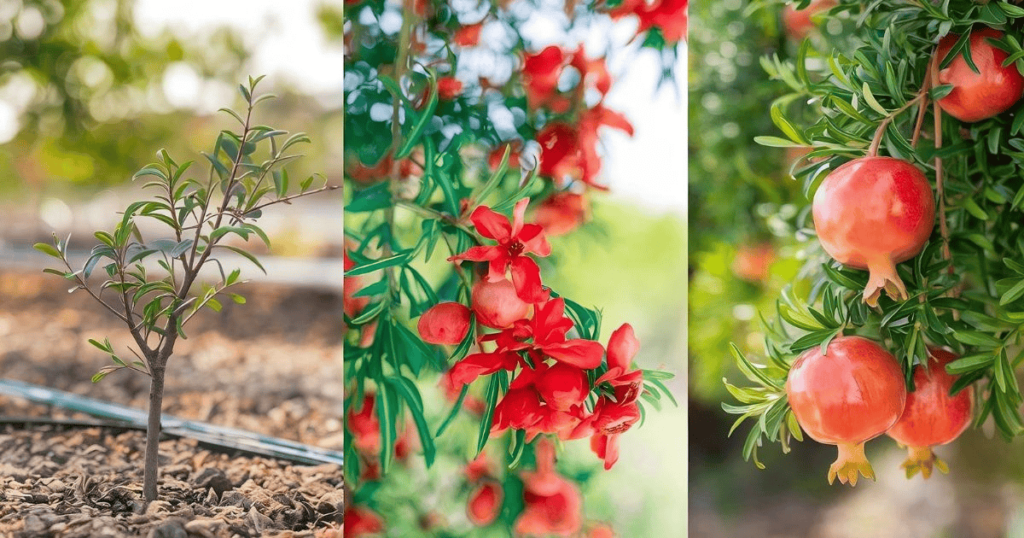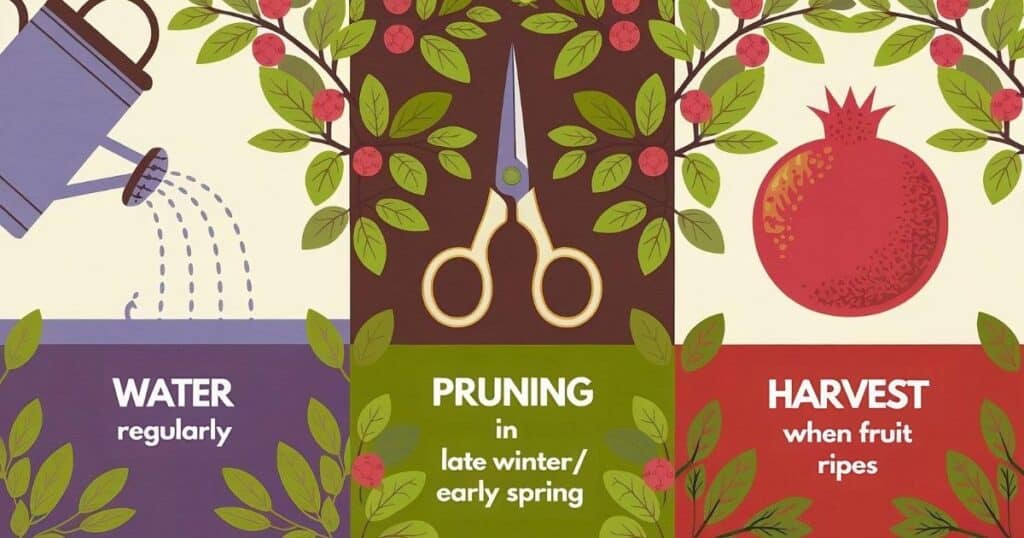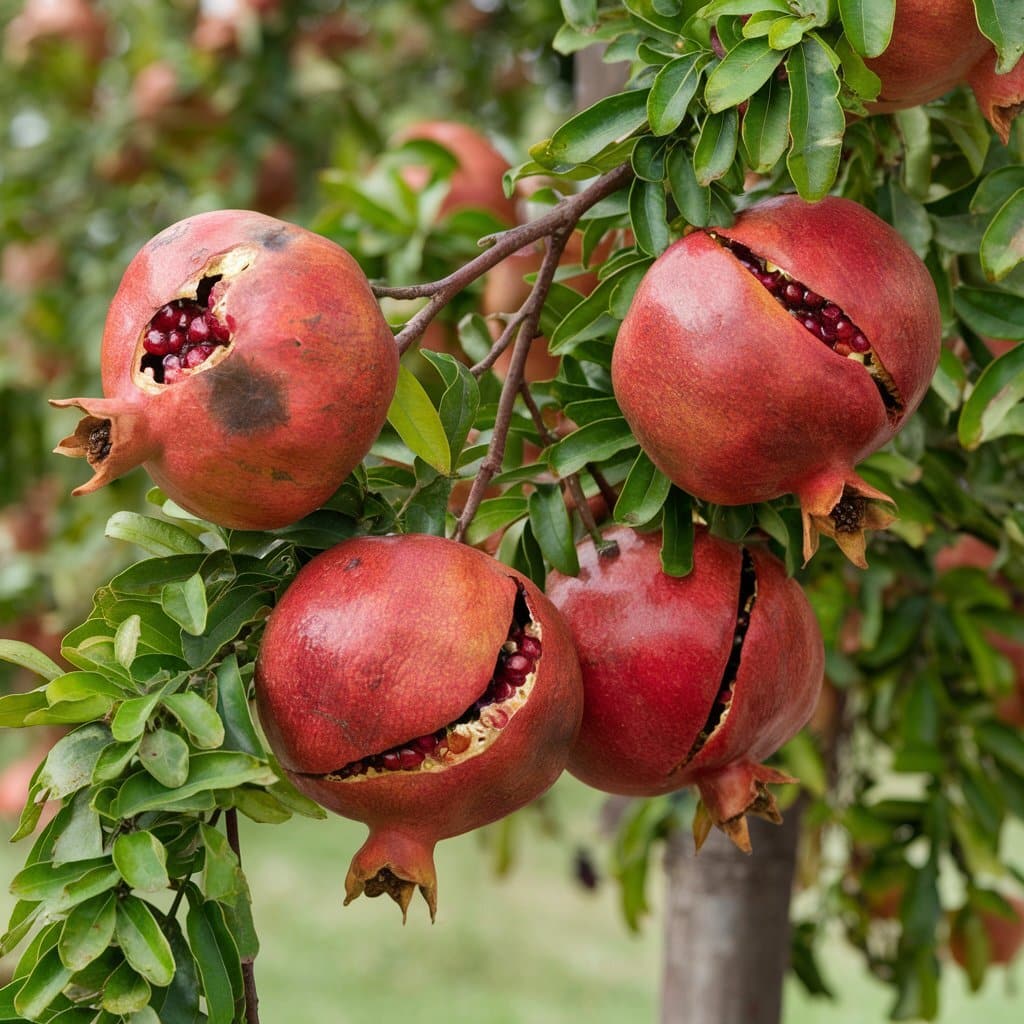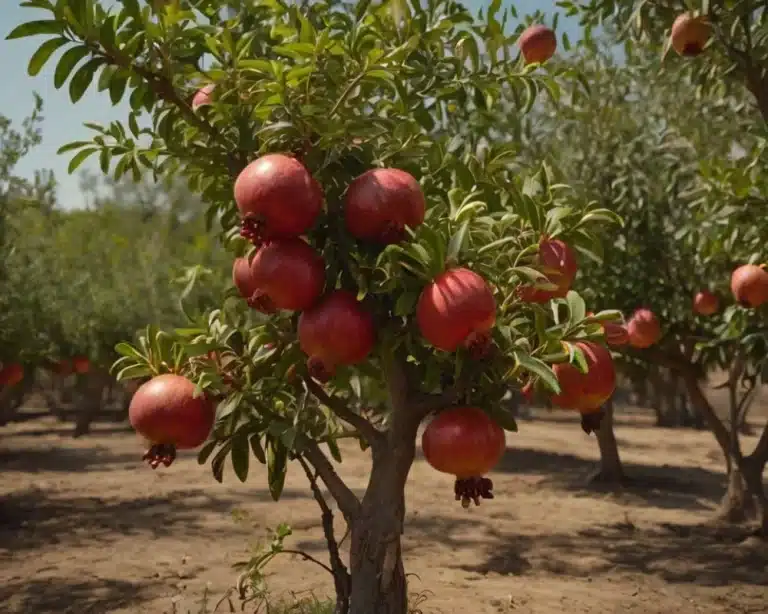Are you interested in adding a touch of elegance and flavor to your garden? A Pomegranate Tree could be the perfect choice for your space. Known for its vibrant fruit and stunning appearance, this tree thrives in both small and large gardens, bringing beauty and delicious rewards. But how do you care for a Pomegranate Tree to ensure it flourishes?
In this guide, we’ll explore everything you need to know about growing and nurturing a Pomegranate Tree. Whether you’re a beginner or a seasoned gardener, you’ll discover simple tips and tricks to help your tree thrive and produce juicy, healthy fruit. Ready to grow your own pomegranate tree? Let’s get started!
Table of Contents
Choosing the Right Location for Your Pomegranate Tree
When it comes to growing a healthy Pomegranate Tree, one of the most important factors to consider is its location. You might be thinking, “But the pomegranate tree is hardy, isn’t it?” While it’s true that pomegranate trees are relatively resilient, they do have specific needs that, if met, can lead to lush growth and abundant fruit.
Why Location Matters
Your pomegranate tree’s location determines its exposure to sunlight, temperature, and wind—three key elements that impact its overall health. Choosing the right spot not only ensures your tree thrives but also increases the likelihood of high-quality, juicy pomegranates. So, how do you know the best spot?
Sunlight is Key
Pomegranate trees love the sun! These trees are known for thriving in areas with full sunlight. In fact, they need at least 6 hours of direct sunlight each day to flourish and produce fruit. If you’re planting in a smaller space, like a balcony or patio, try to position your pomegranate tree in a spot that receives plenty of sun, whether it’s morning or afternoon.
- Best practice: Look for an area that gets sunlight for most of the day. If you’re growing the tree in a container, you can easily move it to the sunniest spot.
Temperature Tolerance
Pomegranates are heat-loving trees, making them ideal for warmer climates. They prefer temperatures between 70°F to 85°F (21°C to 29°C), but they can handle some fluctuations. The tree is also relatively tolerant to drought conditions once it’s established, but it does not thrive in extreme cold.
- Important tip: If you live in a colder climate, consider planting your pomegranate in a pot so you can bring it indoors during the winter months.
Well-Drained Soil
Pomegranates are not particularly picky about soil types, but they do prefer well-drained, sandy or loamy soil. This is important because standing water around the roots can lead to root rot, which is something no gardener wants to deal with. Ensuring proper drainage will help your tree stay healthy and strong.
- Quick tip: If your soil is clay-heavy, try amending it with organic compost to improve drainage.
Protection from Harsh Winds
While pomegranate trees are hardy, they aren’t invincible to strong winds, especially when young. High winds can damage the branches and cause the tree to struggle with growth. If you live in a windy area, try planting your pomegranate tree near a fence or a structure that will act as a natural windbreak.
If you’re considering planting other fruit trees alongside your pomegranate tree, check out our detailed guide on planting fruit trees.
Caring for Your Pomegranate Tree: Essential Tips for Healthy Growth
Now that you’ve chosen the perfect spot for your pomegranate tree, it’s time to dive into the care it needs to thrive. If you’re wondering, “What does a pomegranate tree really need to grow strong and healthy?” don’t worry, we’ve got you covered. Caring for your pomegranate tree isn’t difficult, but it does require some attention to detail. Let’s break down the essential care practices to ensure your tree flourishes.

Watering is one of the most crucial aspects of caring for a pomegranate tree, but it’s easy to get it wrong. Pomegranates are drought-tolerant, which means they don’t need constant watering once established. However, young trees or newly planted pomegranates require regular watering to establish a strong root system.
Watering Your Pomegranate Tree
- Watering tip: Water deeply but infrequently. This encourages deep root growth, making the tree more drought-resistant in the future. Aim to water once every week or two, depending on the weather. If it’s very hot, increase the frequency.
- Warning: Overwatering can lead to root rot. Make sure the soil is well-drained, and always check the soil moisture before watering.
Fertilizing for Growth
Pomegranate trees are not heavy feeders, but they can benefit from a little extra nutrition, especially during the growing season. Fertilizing will promote strong growth and help your tree produce abundant fruit.
- When to fertilize: Apply a balanced fertilizer in early spring, just before the growing season begins. This gives your tree the boost it needs to start the year strong.
- Type of fertilizer: Choose a slow-release fertilizer with a balanced NPK ratio (nitrogen, phosphorus, and potassium). Organic choices such as compost or well-rotted manure are also effective.
Pruning and Shaping Your Pomegranate Tree
Pruning is an important step in keeping your pomegranate tree healthy and productive. Not only does pruning help shape the tree, but it also removes dead or diseased wood, which can help prevent potential issues.
- When to prune: The best time to prune is in late winter or early spring, before new growth begins. This ensures that the tree is ready to grow and bloom once the weather warms up.
- How to prune: Begin by cutting away any dead or damaged branches. Then, focus on thinning out the interior to improve airflow and sunlight penetration. If your tree has become too tall, prune the top to promote lateral growth.
Protecting Your Tree from Pests and Diseases
While pomegranate trees are relatively resistant to pests and diseases, they’re not immune. Keeping an eye on your tree for signs of trouble is key to ensuring its health.
- Common pests: Aphids, pomegranate butterflies, and mealybugs can sometimes target pomegranates. If you notice any of these pests, treat them early with an organic insecticidal soap or neem oil.
- Diseases to watch for: Root rot is a common issue for pomegranates, especially in poorly drained soil. Regularly check for signs of yellowing leaves or wilting, which may indicate a problem.
Harvesting Your Pomegranate Fruit
One of the most exciting parts of growing a pomegranate tree is harvesting the delicious fruit. But when is the best time to pick your pomegranates?
- Signs your fruit is ready: Pomegranates are ready for harvest when the skin turns a rich red color and the fruit sounds hollow when tapped. You should also notice the fruit starting to crack open slightly.
- How to harvest: Use pruning shears or a sharp knife to cut the pomegranate from the tree, leaving a small stem attached. Take care to avoid harming the tree during harvesting.

If you’re growing multiple fruit trees, you might also enjoy learning when to harvest other delicious fruits, such as the persimmon tree.
Troubleshooting Common Pomegranate Tree Problems
Even with the utmost care, things can occasionally go awry. But don’t worry—if your pomegranate tree is showing signs of distress, it’s usually something that can be fixed with a little attention. In this section, we’ll explore some of the most common pomegranate tree problems and how to troubleshoot them, so you can get your tree back on track.
Yellowing Leaves: What’s Happening?
One of the first signs that something might be off with your pomegranate tree is yellowing leaves. But what’s causing it?
Possible causes:

Nutrient deficiency: A lack of key nutrients like nitrogen, iron, or magnesium can cause leaves to turn yellow. This is common in pomegranate trees growing in nutrient-poor soil.
Watering issues: Watering problems: Both excessive and insufficient watering can cause leaves to yellow. Overwatering can cause root rot, while underwatering leads to stress, both of which impact the tree’s ability to absorb nutrients properly.
What to do:
- Fertilize: If nutrient deficiency is the issue, feed your tree with a balanced fertilizer, ideally one with added micronutrients.
- Adjust watering: Ensure the tree is getting the right amount of water, checking soil moisture regularly.
Fruit Cracking: Is It Too Much or Too Little?
Fruit cracking is a common problem with pomegranates, and it can happen for a couple of reasons.
Possible causes:

Uneven watering: Sudden fluctuations in watering can cause the fruit to swell too quickly, resulting in cracks. If the tree experiences dry periods followed by a heavy rain or overwatering, the fruit can burst open.
Overripe fruit: If the pomegranate is left on the tree too long, it can become overripe and crack.
What to do:
- Consistent watering: Try to keep watering consistent. During the fruit’s development phase, make sure the tree gets regular, deep watering without dry spells.
- Harvest at the right time: Keep an eye on the fruit as it matures, and harvest when it’s ripe, but not overly so.
Fruit cracking is a common issue in pomegranate trees, often caused by irregular watering or extreme weather conditions. Maintaining consistent soil moisture and applying mulch can help reduce this problem. To learn more about the causes and solutions of fruit cracking, check out this resource from the University of Maryland.
Pests and Diseases: Keep Them at Bay
Pomegranates are relatively resistant to pests, but that doesn’t mean they’re immune. Aphids, mealybugs, and the pomegranate butterfly are just a few pests that can cause trouble for your tree.
- Common pests:
- Aphids: These small insects can suck sap from your tree, leading to stunted growth and yellowing leaves.
- Pomegranate butterfly: This pest targets the fruit, leaving unsightly damage and sometimes affecting the tree’s overall health.
- Diseases to watch for:
- Root rot: Caused by overwatering, root rot is a serious issue that can kill a pomegranate tree. It often starts with the yellowing of leaves and wilting branches.
- Fungal infections: Wet conditions can encourage fungal growth on the tree’s leaves and fruit, leading to lesions or moldy spots.
- What to do:
- Natural remedies: Use organic insecticidal soap or neem oil to treat pests. These are safe for the tree and the environment.
- Good hygiene: Remove any infected leaves or fruit immediately to prevent the spread of disease.
- Improve drainage: Ensure the tree’s soil is well-drained to avoid root rot. If you’re in an area with high humidity, improving airflow around the tree can also help.
Poor Fruit Production: Why Isn’t My Tree Fruitful?
If your pomegranate tree isn’t producing as much fruit as you’d like, it can be frustrating. Let’s look at some common reasons for this problem.
- Possible causes:
- Lack of pollination: Pomegranates are self-pollinating, but they still require the help of bees or other pollinators. If your tree isn’t getting enough pollinator activity, fruit production may be low.
- Pruning issues: While pruning is necessary for healthy growth, improper pruning can sometimes reduce fruit production. Cutting too much or too little can affect the tree’s ability to flower and bear fruit.
- Environmental stress: Extreme temperatures or inconsistent care can cause your tree to focus on survival rather than fruit production.
- What to do:
- Encourage pollinators: If you don’t see many bees or other pollinators in your garden, consider planting some bee-friendly flowers nearby to attract them.
- Proper pruning: Ensure you’re pruning at the right time and in the right way to encourage healthy flowering.
- Minimize stress: Make sure your tree is getting enough water and nutrients to thrive, and protect it from extreme weather when possible.
Post-Harvest Care & Storage of Pomegranates
Once your pomegranates are harvested, it’s important to handle and store them correctly to extend their shelf life and preserve their flavor. Here’s everything you need to know about keeping your pomegranates fresh:
Storing Whole Pomegranates
If you’re not planning to eat or use your pomegranates right away, store them in a cool, dry place. Ideally, pomegranates last about 1-2 months at room temperature. For longer storage:
- Refrigeration: Place the whole pomegranate in the fridge. This can extend its freshness for up to 3 months.
- Keep them dry: Make sure the skin is dry to prevent mold growth.
Freezing Pomegranate Seeds (Arils)
Freezing is a great option for preserving pomegranate seeds. Here’s how you can do it:
- Remove the seeds: Cut open the pomegranate and remove the arils.
- Freeze individually: Spread the seeds out in a single layer on a baking sheet. Freeze them for a few hours before transferring them to airtight containers or freezer bags.
- Storage: Frozen arils can last up to 6 months. You can use them directly in smoothies, salads, or as a garnish.
Canning Pomegranate Juice
For long-term storage, pomegranate juice is another excellent option. Here’s a step-by-step guide to canning:
- Extract the juice: Use a juicer or manual methods to extract the juice from the arils.
- Sterilize jars: Heat your jars in boiling water to sterilize them.
- Fill and process: Pour the juice into the jars and process them in a boiling water bath for about 10 minutes.
- Seal: Once cooled, check the seals. Canned pomegranate juice can last up to a year when stored in a cool, dark place.

Best Practices for Maintaining Quality
To ensure your pomegranates remain fresh, here are some pro tips:
- Avoid bruising: Handle pomegranates gently, as the skin can easily bruise, affecting both the appearance and taste.
- Use airtight containers: If storing seeds or juice, always use airtight containers to prevent exposure to air and moisture, which can cause spoilage.
By following these methods, you can enjoy your pomegranates far beyond their harvest season, keeping their vibrant flavor and health benefits intact.
Conclusion
Now that you’re equipped with all the essential tips on growing, caring for, and storing pomegranates, it’s time to put your newfound knowledge into action. Whether you’re planting your tree, harvesting those vibrant fruits, or preserving them for later, you can enjoy the satisfaction of caring for a unique and rewarding plant. Have you tried any of these methods yet, or are you eager to start your own pomegranate garden? With the right care and attention, your pomegranate tree will thrive, offering you delicious fruit for seasons to come. Keep experimenting, and let your garden flourish!
FAQ
1. How do I grow a pomegranate tree?
Pomegranate trees flourish in warm, sunny areas with well-drained soil. They require minimal water once established and are best planted in spring. Make sure they receive a minimum of 6 hours of sunlight each day.
2. How can I store pomegranates for longer?
For short-term storage, keep pomegranates in a cool, dry place. For longer storage, refrigerate them, or freeze the arils in airtight containers.
3. When should I harvest my pomegranates?
Pomegranates are ready for harvest when the skin turns deep red and makes a metallic sound when tapped. They typically ripen in late summer to fall.
4. Can pomegranates be grown in cold climates?
Pomegranates prefer warm climates but can tolerate light frost. In colder areas, plant them in containers and move them indoors during winter for protection.


5 thoughts on “Pomegranate Tree: From Planting to Harvest & Storage”